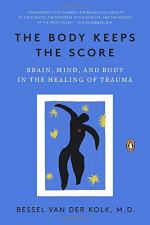
|
| Name: _________________________ | Period: ___________________ |
This test consists of 5 multiple choice questions, 5 short answer questions, and 10 short essay questions.
Multiple Choice Questions
1. At the end of Chapter 7, "Getting on the Same Wavelength: Attachment and Attunement," Van der Kolk asserts that which poet must have had somewhat attentive parents?
(a) T. S. Eliot.
(b) e. e. cummings.
(c) W. H. Auden.
(d) Walt Whitman.
2. Which group(s) of research subjects looking at the photograph of kids watching their father noted danger present in the situation?
(a) Neither traumatized nor normal.
(b) Both traumatized and normal.
(c) Only traumatized.
(d) Only normal.
3. Maria told Van der Kolk that working with horses had allowed her to feel what emotion for the very first time?
(a) Compassion.
(b) Empathy.
(c) Love.
(d) Safety.
4. The system that makes memories fails if the experience is infused with too much what?
(a) Guilt.
(b) Context.
(c) Horror.
(d) Confusion.
5. What does the letter A in the acronym ACE stand for?
(a) Adverse.
(b) Anxious.
(c) Accessible.
(d) Adversarial.
Short Answer Questions
1. What type of abuse most often results in total memory loss?
2. In Chapter 8: “Trapped in Relationships: The Cost of Abuse and Neglect,” Van der Kolk claims that victims of sexual abuse are often diagnosed with ADD if a doctor focuses on which symptom?
3. How does Van der Kolk describe the patterns of a survivor of unresolved trauma?
4. To whom is the epigraph for Chapter 7, "Getting on the Same Wavelength: Attachment and Attunement" attributed?
5. Which kind of ACE scores are associated with the greatest chances of problems relating to trauma?
Short Essay Questions
1. What book published in 1929 refocused the public's attention back onto the issue of trauma?
2. What is "Auden's Rule" (125) and what is its purpose?
3. What does Van der Kolk see as the main barrier to survivors of child sexual abuse receiving the help they need?
4. Describe an instance when Van der Kolk points out the irony in a particular societal situation.
5. What is "False Memory Syndrome" and how does Van der Kolk view it?
6. What sort of therapy was prescribed to Maria when other methods were ineffective?
7. What is the main claim put forth in the book by Pierre Janet discussed in Chapter 11, "Uncovering Secrets: The Problems of Traumatic Memory"?
8. What events are more likely to happen in the future of someone who earns a high ACE score?
9. Who was Pierre Janet and what is the name of the book he wrote that strongly influenced Van der Kolk?
10. Before World War I began, what was the most prominently used method of providing mental health support?
|
This section contains 1,021 words (approx. 4 pages at 300 words per page) |

|




